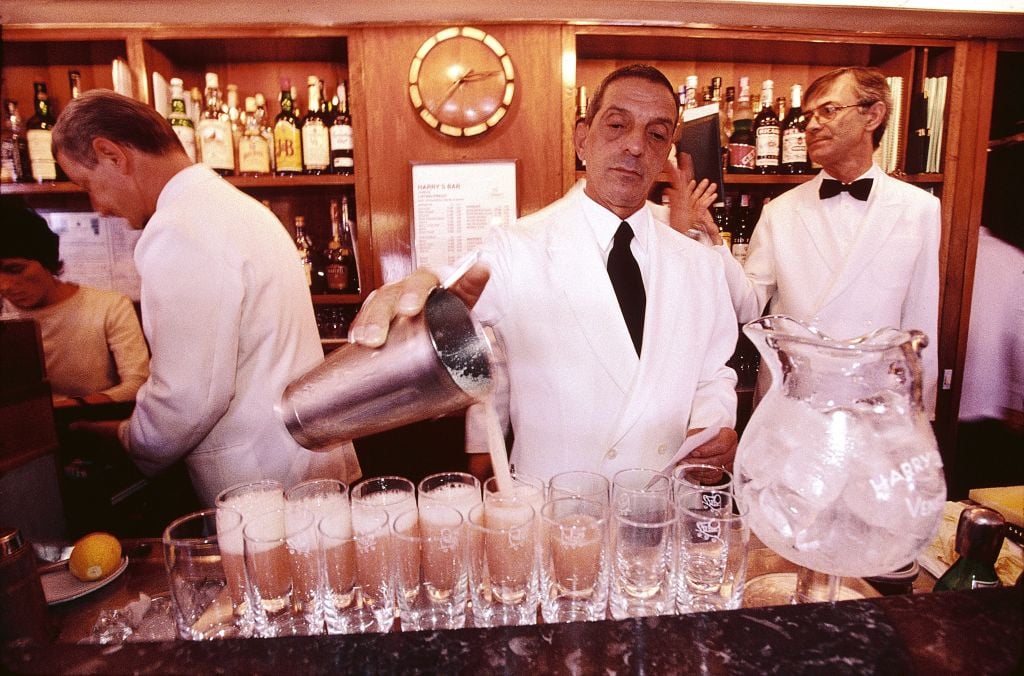
A new bar named after Francisco Clemente is opening up above the Michelin-starred vegan restaurant Eleven Madison Park in New York’s Flatiron neighborhood this fall; the news marks just another chapter in the long-running relationship between art and alcohol. French painter Henri de Toulouse-Lautrec, for instance, considered a buzz necessary to understand a painting. Plus, it’s oft-repeated lore that the bellini, that staple of bottomless brunch, is named for the Italian Renaissance artist Giovanni Bellini.
The bellini was invented at Harry’s Bar in Venice, a watering hole favored during every Venice Biennial by the art world, situated just off the city’s grand canal. In 2001, the Italian government declared this spot a national landmark. Ever since Giuseppi Cipriani Sr. opened Harry’s Bar in 1931, using money gifted from a recovering alcoholic he’d once helped out, the rarefied establishment has hosted everyone from Frank Lloyd Wright to Peggy Guggenheim.
Ernest Hemingway wrote Across the River and Into the Trees while sitting there, and made Cipriani the only real-life character ever outright named in one of his works. The Bellini is said to have become the author’s go-to order.
Photo: In Pictures Ltd./Corbis via Getty Images.
(By the way, there are numerous Harry’s Bars around the world, but the other big one, Harry’s New York Bar in Paris—Basquiat’s favorite, where the Bloody Mary was invented—is entirely unrelated.)
Cipriani concocted and named the drink during the summer of 1948. For the uninitiated, a bellini is crafted from two parts prosecco and one part peach puree, served chilled without ice; it is typically poured in a champagne flute, but notably not at Harry’s Bar. In the beginning, white peaches were the only proper ingredient, but yellow peaches and peach nectar have become acceptable, too. Like all offerings at Harry’s Bar, this sweet yet tart, frothy drink started as a seasonal special. Some accounts state that during bellini season, the establishment employed staff just to squeeze the peaches. With increased prominence and supply chain know-how, the Bellini has become a year-round favorite.
Giovanni Bellini, Feast of the Gods (1514). Collection of the National Gallery of Art.
Meanwhile, Venetian artist Giovanni Bellini stands out amongst the Italian Renaissance for his dramatic shadows and decadent hues, sometimes painted with a fiery orange called Orpiment that’s now considered toxic. Bellini helped revolutionize the style of the Italian Renaissance, not only through sensuous works like The Sacred Conversation (c. 1487) and The Feast of the Gods (1514), but also by teaching pupils like Titian.
Today, Bellini’s paintings are owned by the Frick Collection in New York and England’s Royal Family. They’ve also appeared in major exhibitions and high fashion campaigns over the past year alone.
Giovanni Bellini, Portrait of Doge Leonardo Loredan (1501). Photo by VCG Wilson/Corbis via Getty Images.
Cipriani chose Bellini to become his creation’s namesake based on the peachy tints that characterize both the drink and Bellini’s palette, particularly in The Agony in the Garden (1458–60) and Doge Leonardo Loredan (1501). Chilled reports that in the beginning, Harry’s Bar even added a bit of raspberry juice to enhance the comparison.
What’s more, the bellini isn’t the only offering that Harry’s Bar named after an artist. They also invented carpaccio, a dish of thinly sliced raw beef named after Venetian Renaissance artist Vittore Carpaccio. So, next time you pour one back, remember you’re participating in more than one time-honored tradition.